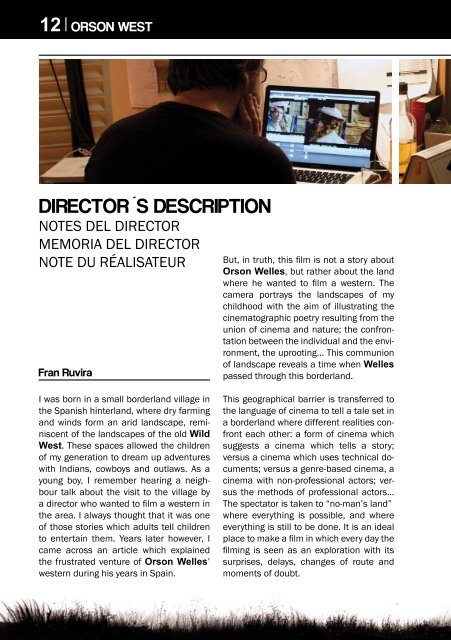You also want an ePaper? Increase the reach of your titles
YUMPU automatically turns print PDFs into web optimized ePapers that Google loves.
12 <strong>ORSON</strong> <strong>WEST</strong> <strong>ORSON</strong> <strong>WEST</strong> 13<br />
DIRECTOR´S <strong>DE</strong>SCRIPTION<br />
NOTES <strong>DE</strong>L DIRECTOR<br />
MEMORIA <strong>DE</strong>L DIRECTOR<br />
NOTE DU RÉALISATEUR<br />
Fran Ruvira<br />
I was born in a small borderland village in<br />
the Spanish hinterland, where dry farming<br />
and winds form an arid landscape, reminiscent<br />
of the landscapes of the old Wild<br />
West. These spaces allowed the children<br />
of my generation to dream up adventures<br />
with Indians, cowboys and outlaws. As a<br />
young boy, I remember hearing a neighbour<br />
talk about the visit to the village by<br />
a director who wanted to film a western in<br />
the area. I always thought that it was one<br />
of those stories which adults tell children<br />
to entertain them. Years later however, I<br />
came across an article which explained<br />
the frustrated venture of Orson Welles’<br />
western during his years in Spain.<br />
But, in truth, this film is not a story about<br />
Orson Welles, but rather about the land<br />
where he wanted to film a western. The<br />
camera portrays the landscapes of my<br />
childhood with the aim of illustrating the<br />
cinematographic poetry resulting from the<br />
union of cinema and nature; the confrontation<br />
between the individual and the environment,<br />
the uprooting... This communion<br />
of landscape reveals a time when Welles<br />
passed through this borderland.<br />
This geographical barrier is transferred to<br />
the language of cinema to tell a tale set in<br />
a borderland where different realities confront<br />
each other: a form of cinema which<br />
suggests a cinema which tells a story;<br />
versus a cinema which uses technical documents;<br />
versus a genre-based cinema, a<br />
cinema with non-professional actors; versus<br />
the methods of professional actors…<br />
The spectator is taken to “no-man’s land”<br />
where everything is possible, and where<br />
everything is still to be done. It is an ideal<br />
place to make a film in which every day the<br />
filming is seen as an exploration with its<br />
surprises, delays, changes of route and<br />
moments of doubt.<br />
In this way, the film gradually reveals itself<br />
as it progresses, and the narration itself<br />
becomes the testimony of a quest. The<br />
film adopts a form of a sketch or scribbled-down<br />
story, even more so when we<br />
talk about one of the unfinished projects<br />
of Welles or the personal stories of the<br />
past in need of closure. With this view,<br />
and with the help of filmmaker Joaquim<br />
Jordà, I began to write a script where real,<br />
epic and legendary events coexist, like any<br />
good western.<br />
The cast is headed by Sonia Almarcha,<br />
an actress with a long career behind her,<br />
who we saw in Solitary Fragments, by Jaime<br />
Rosales (2007) and who, in fact, was<br />
born in the area. Once again, the frontier<br />
between fiction and reality, the actress and<br />
the character, evaporate in a game of (re)<br />
interpretation in favour of the film. The arrival<br />
of the film crew to the village represents<br />
the coming home for the main actress to<br />
her land of birth. This return brings to light<br />
past conflicts triggered by memory. Sonia<br />
is incapable of laying down personal roots<br />
and tries instead to conquer faraway lands:<br />
the passage of irrecoverable time, lost love,<br />
insecurities… Borders are also invisible barriers<br />
which stand in the way of personal<br />
relations.<br />
We wanted to mix professional and nonprofessional<br />
actors in order to seek naturalness<br />
in their gesture and portray from<br />
an ethnographical viewpoint aspects such<br />
as the dialect of the area and its customs,<br />
etc… With this in mind, a group of children<br />
become attentive observers of the world<br />
of cinema. The unspoilt way of looking of<br />
these children who are not actors help us<br />
to recover our lost innocence and nativity<br />
of the first viewing with the aim of finding<br />
that maxim which states that the western<br />
provides satisfaction to the lost childhood<br />
of the adult spectator.<br />
And finally, I, as director of the film,<br />
“appear” in front of the camera, exploring<br />
the details of the western which was never<br />
filmed. Together with the spectator, we<br />
wanted to begin a story which would take<br />
us in search of the ghost of Orson and his<br />
unfinished film. The life and interrupted<br />
projects of Orson Welles are surrounded<br />
by confusing incognitos and half-truths,<br />
which make it impossible to tell apart<br />
what is real from legend. This is why the<br />
investigation is condemned to failure from<br />
the first moment but as John Ford said:<br />
“when you have to choose between truth<br />
and myth, print the myth”.<br />
In summary, with Orson West we want<br />
to continue exploring new territories of<br />
cinema which mix genres, materials, fiction,<br />
documentary... in favour of cinema<br />
as an impure art. But above all, Orson<br />
West is a realist, intimate and poetic film<br />
which seeks to find again the (false) innocence<br />
of cinema.


